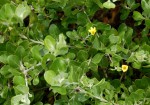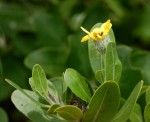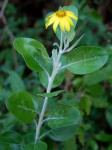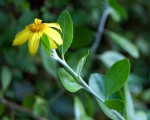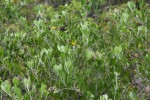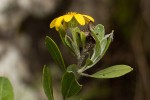Chrysanthemoides monilifera
septentrionale
Selected images: Click on each image to see a larger version and details of the record View all images (14)
Detailed records: Display species records QDS maps by: Google Maps Point records by Google Maps
Species details: Click on each item to see an explanation of that item (Note: opens a new window)
| Synonyms: |
Osteospermum moniliferum sensu Engl. |
| Common names: | Bush-tick berry (English) |
| Frequency: | Frequent |
| Status: | Native |
| Description: |
Usually a much-branched shrub, rarely a small tree. Young leaves and branches densely covered in woolly, cobweb-like hairs, becoming more or less hairless when older. Leaves spirally arranged, broadly oblanceolate to obovate, 1.5-7.5 cm long, leathery, tapering at the base into a winged petiole 5-10 mm long; margin toothed. Capitula several together or solitary, terminal and axillary, bright yellow, up to 4 cm in diameter. Ray-florets 7-10 with 3 apical teeth on the ligule. Involucral bracts 2-4 seriate. |
| Type location: |
|
| Notes: | The species is unusual within Asteraceae in that it produces a ring of berry-like fruits. |
| Derivation of specific name: | |
| Habitat: | On rocky hillsides, woodland, (sub)montane grassland and along the margins of evergreen forest. |
| Altitude range: (metres) | 900 - 2400 m |
| Flowering time: | May - Oct |
| Worldwide distribution: | (this subspecies)Southern Kenya, Tanzania, Malawi, Mozambique, Zimbabwe and Limpopo (Soutpansberg) South Africa. |
| FZ divisions: | T,MS |
| Growth form(s): | |
| Endemic status: | |
| Red data list status: | |
| Insects associated with this species: | |
| Spot characters: | Display spot characters for this species |
| Images last updated: | Friday 4 October 2024 |
| Literature: |
Baumann, G. (2005). Photographic Guide to Wildflowers of Malawi Wildlife and Environmental Society of Malawi Pages 176 - 177. (Includes a picture). Burrows, J.E. & Willis, C.K. (eds) (2005). Plants of the Nyika Plateau Southern African Botanical Diversity Network Report No. 31 SABONET, Pretoria Page 87. (Includes a picture). Burrows, J.E., Burrows, S.M., Lötter, M.C. & Schmidt, E. (2018). Trees and Shrubs Mozambique Publishing Print Matters (Pty), Cape Town. Page 1020. (Includes a picture). Chapano, C. & Mamuto, M. (2003). Plants of the Chimanimani District National Herbarium and Botanic Garden, Zimbabwe Page 13. as Chrysanthemoides monilifera canescens Coates Palgrave, K. (revised and updated by Meg Coates Palgrave) (2002). Trees of Southern Africa 3rd edition. Struik, South Africa Pages 1148 - 1149. (Includes a picture). Da Silva, M.C., Izidine, S. & Amude, A.B. (2004). A preliminary checklist of the vascular plants of Mozambique. Southern African Botanical Diversity Network Report No. 30 Sabonet, Pretoria Page 30. Drummond, R.B. (1975). A list of trees, shrubs and woody climbers indigenous or naturalised in Rhodesia. Kirkia 10(1) Page 278. As Chrysanthemoides monilifera septentrionalis Mapaura, A. & Timberlake, J. (eds) (2004). A checklist of Zimbabwean vascular plants Southern African Botanical Diversity Network Report No. 33 Sabonet, Pretoria and Harare Page 24. Norlindh, T. (1978). The Compositae of the Flora Zambesiaca area. 10. Calenduleae. Kirkia 11(1) Pages 158 - 161. (Includes a picture). Strugnell, A.M. (2006). A Checklist of the Spermatophytes of Mount Mulanje, Malawi Scripta Botanica Belgica 34 National Botanic Garden of Belgium Page 51. Van Wyk, B. & Van Wyk, P. (1997). Field Guide to Trees of Southern Africa. Struik, South Africa Pages 134 - 135. as Chrysanthemoides monilifera (Includes a picture). White, F., Dowsett-Lemaire, F. & Chapman, J.D. (2001). Evergreen forest flora of Malawi Royal Botanic Gardens, Kew Pages 201 - 202. (Includes a picture). Wursten, B., Timberlake, J. & Darbyshire, I. (2017). The Chimanimani Mountains: an updated checklist. Kirkia 19(1) Page 88. |
Other sources of information about Chrysanthemoides monilifera subsp. septentrionale:
Our websites:
Flora of Malawi: Chrysanthemoides monilifera subsp. septentrionaleFlora of Zimbabwe: Chrysanthemoides monilifera subsp. septentrionale
External websites:
African Plants: A Photo Guide (Senckenberg): Chrysanthemoides moniliferaAfrican Plant Database: Chrysanthemoides monilifera
BHL (Biodiversity Heritage Library): Chrysanthemoides monilifera
EOL (Encyclopedia of Life): Chrysanthemoides monilifera
GBIF (Global Biodiversity Information Facility): Chrysanthemoides monilifera
Google: Web - Images - Scholar
iNaturalist: Chrysanthemoides monilifera
IPNI (International Plant Names Index): Chrysanthemoides monilifera
JSTOR Plant Science: Chrysanthemoides monilifera
Mansfeld World Database of Agricultural and Horticultural Crops: Chrysanthemoides monilifera
Plants of the World Online: Chrysanthemoides monilifera
Tropicos: Chrysanthemoides monilifera
Wikipedia: Chrysanthemoides monilifera
